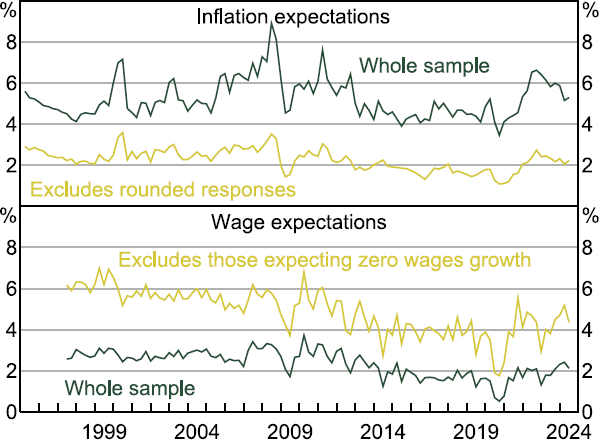RDP 2024-07: How Do Households Form Inflation and Wage Expectations? 3. Data Description
October 2024
- Download the Paper 1.59MB
The data we use come from the Melbourne Institute consumer survey. The survey is conducted monthly using a stratified random sample of about 1,200 households as a repeated cross-section. We use data from 1997 to mid-2024. The survey is stratified along several dimensions and weights are used to approximate the Australia population. We apply these weights for any aggregations.
We build up our measures of expectations from the unit record data, which alongside the expectations questions include various questions around socio-demographic information (e.g. sex, age, income, occupation and education), the respondent's assessment of a range of economic variables (including inflation expectations) and household finances.[1] This allows us to do individual-level analysis, as well as building up aggregate average time series for the total population and for certain demographic groups.
The two core expectations questions used in this paper are as follows:
- Inflation expectations: Consumers are asked how they expect the ‘prices of things you buy’ to change over the next year; if respondents state that prices will go ‘up’ or ‘down’, they are then asked to provide a numerical estimate for the expected change.
- Wage expectations: Consumers are asked how they expect their ‘hourly wage rate or salary or pay’ to change over the coming 12 months; if respondents state that wages will go ‘up’ or ‘down’, they are then asked to provide a numerical estimate for the expected change.
Consumers are also asked similar questions about their perceptions of price and wage changes over the past 12 months. The wages question is asked in terms of ‘total pay’, which is a slightly different concept. Though analysis suggests that people answer the two with similar notions in mind.
It is worth highlighting here that these are relatively short-term expectations. Longer-term expectations are not available in the dataset, so we cannot explore their formation.
We apply some cleaning and trimming to the expectations data. Specifically, for all analysis we trim expectations (and perceptions) below –50 per cent and above 50 per cent.
For inflation expectations, we consider two different series across the analysis. One uses the remaining data as is. The other removes rounded responses (multiples of 5) from both averages and unit-level regressions. In part this is motivated by the fact that these rounded responses contribute to a large upward bias in average reported inflation expectations relative to historical inflation outcomes (approximately 2.7 per cent over the sample). While there are other methods of removing this bias, previous research has found that changes in these rounded responses tend to reflect changes in uncertainty, with households responding in round numbers when they are uncertain about actual inflation (e.g. Binder 2017; Reiche and Meyler 2022). And while uncertainty affects decision-making, the mechanism is separate to how inflation expectations affect decisions. Removing rounded responses is therefore a more transparent and well-justified approach to removing this bias than other methods.
For wage expectations, we again consider two measures. The first uses all responses (after initial trimming). The second removes respondents reporting zero wages growth. This is because there is a large mass of people reporting zero expected or perceived wage gains – around half the sample. This is well above actual shares of wage freezes according to other sources, such as the ABS wage price index (WPI). As such, it appears that many respondents may be responding inaccurately, or reporting no gains in a very broad sense. In part this may reflect the nature of the question, where people are first asked if their wages changed, and then asked if so by how much (and if not they are recorded as zero). As we cannot differentiate ‘true’ zero expectations from these potentially imprecise responses we remove all zeros in our preferred metrics.
Table 1 provides some high-level summary statistics for the overall sample, and our preferred expectations metrics. Our preferred metrics end up removing around half the sample. Removing the zeros from the wage expectations data unsurprisingly lifts the mean value significantly. The full and exclusion series tend to follow quite similar patterns over time, the latter tends to be a bit smoother, especially for inflation expectations (Figure 1).
| Observations | Mean | Median | Standard deviation | Sample period | |
|---|---|---|---|---|---|
| Inflation expectations | 381,472 | 5.21 | 5.00 | 7.62 | Jan 1995–Jun 2024 |
| Inflation expectations (excluding rounded responses) | 201,009 | 2.19 | 2.00 | 3.37 | Jan 1995–Jun 2024 |
| Wages expectations | 180,788 | 2.34 | 0.00 | 7.04 | Apr 1997–Jun 2024 |
| Wages expectations (excluding zero wages growth) | 83,447 | 4.93 | 4.00 | 9.57 | Apr 1997–Jun 2024 |
|
Sources: Authors' calculations; Melbourne Institute. |
|||||

Sources: Authors' calculations; Melbourne Institute.
Footnote
For an analysis of households' year-ahead inflation expectations, see Haidari and Nolan (2022). [1]